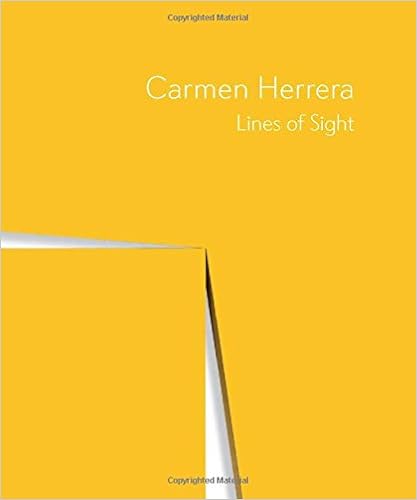
Carmen Herrera, born 1915, is still active making works of paper and painting in an apartment on East Nineteenth Street. She has been in this flat since 1938, when she married the American Jesse Lowenthal and left her native Cuba for New York. Whitney curator Dana Miller feels that the crucial make or break moment for Herrera came after World War II, when she and Lowenthal left for a Paris soujourn. This is Miller's assertion, and the book is filled with color plates that suggest this may be true. Miller evinces the spectacle of the American Ellsworth Kelly, nearly Herrera's contemporary and one who was making work in Paris at the very same time—oddly resonant—and though Kelly and Herrera each denied meeting the other or knowing of the other's work in Paris at the time, Miller keeps coming back to this point of comparison and indeed, a conspiracy theorist would so crazy thinking of the number of "coincidences" linking the two during this decade long stretch. Miller says she is bringing Kelly into her sketch of Herrera's career for "context, not for comparison." The most striking is that, towards the end of his time in Paris, Kelly was already acquiring significant representation and management, and was beginning to seem like a star when Dorothy Miller picked him for her epochal 1960 "Sixteen Americans" exhibition, whereas Carmen Herrera became pigeonholed and relegated to shows about Latin American artists. She is glum when speaking about her dark years, saying that because she was Latin, because she was a woman,a nd because she was a minimalist, there was no space for her in the Greenberg-dominated art world of Abstract Expressionism, while the boys of minimalism likewise ignored her, "I was too old for them," she says.
It is said that she made not a single sale until she was 82! Hard to believe, and I kept waiting for the book to tell us how she kept a roof over her head for more than eight decades of no sales. Perhaps a career retrospective catalogue is not the place to ask for money facts, but one wonders how, when so many women gave up art because they could not afford the poverty, Herrera kept making picture after picture, some quite large, all through the blank years in which she was a nothing. Her low point was 1964, in which Miller has not been able to find any record of Herrera working on paintings, but we get the point that it was personal feelings—the deaths of family members and the tensions over Cuba in the World War of the early 60s, that caused this year of dryness. (By 1965 she was back to painting full time.) The 70s brought the famous series "The Days of the Week," and other career highlights. Her husband died at age 92, and mourning was difficult. She had lived so many lives by the year 2000, and success was right around the corner. That she is still alive and working as hard as ever is a medical fact, I suppose; Dana Miller argues that, contra Herrera herself—who complained that she was always in the wrong place at the wrong time—she was in fact in the right place at the right time all the way through.
In May 2016 painter Kathe Burkhart brought me to a show of Herrera's most recent work, and I took a photo of some representative work—with Kathe walking in front of it, dazzled, in awe. It was a beautiful moment in my life and I'm glad it led me to this curious catalogue.
No comments:
Post a Comment